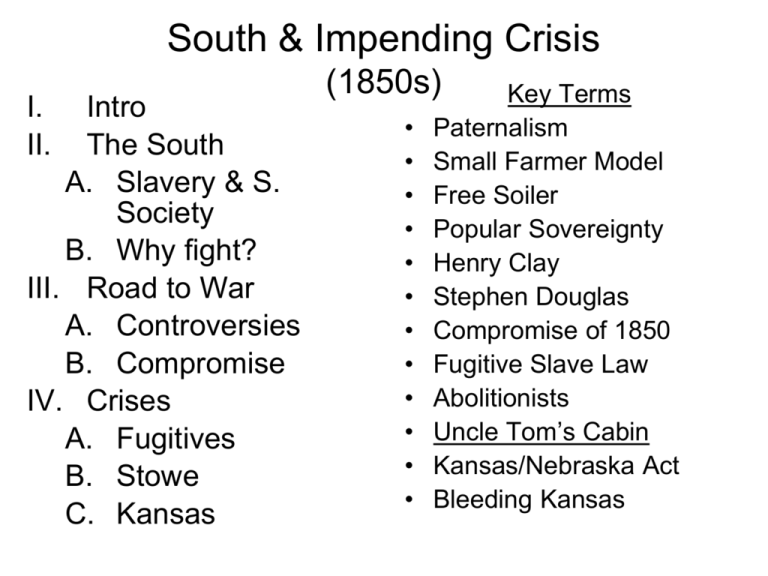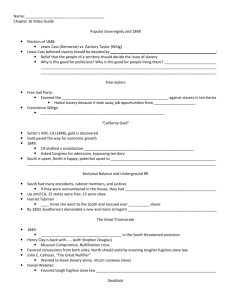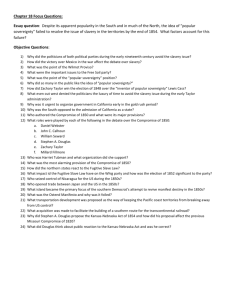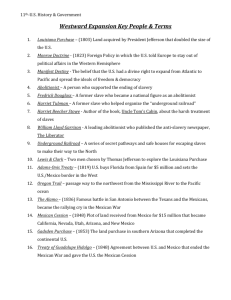Impending Crisis (1850s) - West Shore Community College
advertisement

South & Impending Crisis I. II. Intro The South A. Slavery & S. Society B. Why fight? III. Road to War A. Controversies B. Compromise IV. Crises A. Fugitives B. Stowe C. Kansas (1850s) • • • • • • • • • • • • Key Terms Paternalism Small Farmer Model Free Soiler Popular Sovereignty Henry Clay Stephen Douglas Compromise of 1850 Fugitive Slave Law Abolitionists Uncle Tom’s Cabin Kansas/Nebraska Act Bleeding Kansas Slavery & The Bible • Various passages were used to justify slavery. – “Curse of Ham” Slavery & History 1. Ancient Greeks & Romans owned slaves. 2. US Constitution protected slavery: – 3/5 Compromise – Fugitive Slave Provision Slavery & Social Justification Paternalism • Slaves were like children (family) in need of help. • Slaves were provided with food and shelter. • “Civilization” and Christianity were brought to people considered heathens. Slaves were treated better Virginia Planter's Family by than Northern factory August Köllner, 1845 workers. Southern Society (1860) Society Was Very Stratified • Great Planters (1% of pop: 20+ slaves) • Small Farmers (35-45% of pop: 0-5 slaves = most common) • Landless Whites (20-25% of pop) • Slaves (35% of pop) About 75% of Southern Whites were NOT slaveholders Virginia: Community Life River Small Farmer Model Why would a Southern white male fight to protect slavery if he didn’t own slaves? 1. Large plantation was the social center of life. 2. Large planters lent small farmers a “helping hand” VERY often. 3. A small farmer’s goal: to become a big planter! The entire system was based on slave labor; at least they weren’t black slaves! Controversy/Concerns After Mexican War • Would slavery expand into newly acquired land? • What about Texas (border & debt) & California? • Some felt slavery in WA DC was embarrassing for the nation A group of slaves passing by the US Capital Different Solutions 1. Free Soilers All new territory should be FREE (prohibit slavery). 2. Popular Sovereignty Allow people who live in new territories for vote and decide themselves. 3. Extend Missouri Compromise line Who Can Develop A Compromise? Henry Clay Stephen Douglas •He failed •He succeeded Compromise Of 1850 1. California entered Union as a free state 2. Slavery in Utah & New Mexico territories will be decided by popular sovereignty 3. Texas border was settled & their debt was paid Douglas 4. The slave trade was outlawed in WA DC (but slavery remained legal) 5. A stricter Fugitive Slave Law Significance: Compromise Of 1850 • Its Impact: It averted war for 10 years. Presidents & The Compromise Zachary Taylor Millard Filmore (1849-50) (1850-1853) Fugitive Slave Law (Part of Compromise of 1850) 1. All runaway slaves had to be returned to their owners. 2. It became illegal to aid runaway slaves. 3. Accused runaways were denied a jury trial; a judge decided their fate. • It INFURIATED opponents of slavery & showed slavery was a national problem, not regional. Escaping From Slavery Boston’s Park Street Church Hosted many antislavery rallies Uncle Tom’s Cabin (1852) Harriet Beecher Stowe Her Goal: Show horrors of slavery. •National & international best-seller •Its Impact: It infuriated North AND South •“So, you’re the little lady…” A Slave Family Is Ripped Apart Uncle Tom’s Final Beating Abolitionists • Condemned slavery as immoral and called for an immediate end to slavery. • Strongest in New England, but still very small in number. The Liberator Publisher William Lloyd Garrison Kansas & Nebraska (Background) • Northerners supported a railroad out West • Southerners wanted slavery to expand • Stephen Douglas wanted to be President; wanted support of North & South! Kansas/Nebraska Act (1854) 1. Organized two new territories: Kansas & Nebraska. 2. The Missouri Compromise was repealed. 3. Slavery in Kansas & Nebraska was to be determined by Popular Sovereignty. Stephen Douglas Angered many in the North; they feared slavery would expand into new areas! Bleeding Kansas (1855-56) • Supporters & opponents of slavery converged in Kansas. • This led to bloodshed between the two groups. • Pottawatomie Creek Massacre John Brown South & Impending Crisis I. II. Intro The South A. Slavery & S. Society B. Why fight? III. Road to War A. Controversies B. Compromise IV. Crises A. Fugitives B. Stowe C. Kansas (1850s) • • • • • • • • • • • • Key Terms Paternalism Small Farmer Model Free Soiler Popular Sovereignty Henry Clay Stephen Douglas Compromise of 1850 Fugitive Slave Law Abolitionists Uncle Tom’s Cabin Kansas/Nebraska Act Bleeding Kansas







